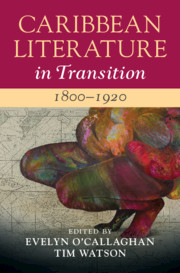14 results
Contributors
-
- Book:
- Caribbean Literature in Transition, 1800–1920
- Published online:
- 16 December 2020
- Print publication:
- 14 January 2021, pp x-xvi
-
- Chapter
- Export citation
Bibliography
-
- Book:
- Caribbean Literature in Transition, 1800–1920
- Published online:
- 16 December 2020
- Print publication:
- 14 January 2021, pp 426-465
-
- Chapter
- Export citation
List of Illustrations
-
- Book:
- Caribbean Literature in Transition, 1800–1920
- Published online:
- 16 December 2020
- Print publication:
- 14 January 2021, pp viii-ix
-
- Chapter
- Export citation
Part IV - Critical Transitions
-
- Book:
- Caribbean Literature in Transition, 1800–1920
- Published online:
- 16 December 2020
- Print publication:
- 14 January 2021, pp 357-425
-
- Chapter
- Export citation
Part III - The Caribbean Region in Transition
-
- Book:
- Caribbean Literature in Transition, 1800–1920
- Published online:
- 16 December 2020
- Print publication:
- 14 January 2021, pp 213-356
-
- Chapter
- Export citation
Chapter 4 - Caribbean Picturesque from William Beckford to Contemporary Tourism
- from Part I - Literary and Generic Transitions
-
-
- Book:
- Caribbean Literature in Transition, 1800–1920
- Published online:
- 16 December 2020
- Print publication:
- 14 January 2021, pp 67-84
-
- Chapter
- Export citation
Contents
-
- Book:
- Caribbean Literature in Transition, 1800–1920
- Published online:
- 16 December 2020
- Print publication:
- 14 January 2021, pp v-vii
-
- Chapter
- Export citation
Part I - Literary and Generic Transitions
-
- Book:
- Caribbean Literature in Transition, 1800–1920
- Published online:
- 16 December 2020
- Print publication:
- 14 January 2021, pp 15-134
-
- Chapter
- Export citation
Index
-
- Book:
- Caribbean Literature in Transition, 1800–1920
- Published online:
- 16 December 2020
- Print publication:
- 14 January 2021, pp 466-482
-
- Chapter
- Export citation
Copyright page
-
- Book:
- Caribbean Literature in Transition, 1800–1920
- Published online:
- 16 December 2020
- Print publication:
- 14 January 2021, pp iv-iv
-
- Chapter
- Export citation
Part II - Cultural and Political Transitions
-
- Book:
- Caribbean Literature in Transition, 1800–1920
- Published online:
- 16 December 2020
- Print publication:
- 14 January 2021, pp 135-212
-
- Chapter
- Export citation
Acknowledgements
-
- Book:
- Caribbean Literature in Transition, 1800–1920
- Published online:
- 16 December 2020
- Print publication:
- 14 January 2021, pp xvii-xviii
-
- Chapter
- Export citation
Introduction
-
-
- Book:
- Caribbean Literature in Transition, 1800–1920
- Published online:
- 16 December 2020
- Print publication:
- 14 January 2021, pp 1-14
-
- Chapter
- Export citation

Caribbean Literature in Transition, 1800–1920
-
- Published online:
- 16 December 2020
- Print publication:
- 14 January 2021



